Coronavirus Today: A vaccine at last
- Share via
Good evening. I’m Amina Khan, and it’s Friday, Dec. 11. Here’s the latest on what’s happening with the coronavirus, plus ways to spend your weekend and a look at some of the week’s best stories.
It’s official: The Food and Drug Administration has granted emergency use authorization to the COVID-19 vaccine developed by Pfizer Inc. and its partner BioNTech. The decision was announced Friday night after the White House put pressure on the agency’s chief to make the call by the end of the day.
Emergency use authorization of the two-dose vaccine opens a new chapter in the fight against the deadly disease that scientists, health officials and a beleaguered public all hope will mark the beginning of the pandemic’s end. The first immunizations could begin in a matter of days.
The Pfizer-BioNTech vaccine was endorsed Thursday by a scientific advisory panel after hours of testimony and debate. In Phase 3 trials involving more than 43,000 volunteers, the vaccine was 95% effective in reducing the risk of developing COVID-19 — easily surpassing the agency’s requirements for both safety and efficacy.
Scientists said they were impressed that the vaccine performed so well, even for people considered to be at higher risk of developing more serious cases of COVID-19. For instance, the vaccine was 94% effective for those who were at least 56 years old, 95% effective for those with at least one high-risk medical condition and 96% effective for those who were obese.
In addition, the vaccine was essentially equally effective for Latinos (94.5%) and non-Latinos (94.7%), and it was 100% effective among the Black study participants.
“The good news couldn’t come any sooner,” said Dr. Margaret Hamburg, who led the FDA during the Obama administration. “We can begin to see the light at the end of the tunnel.”
Several members of the advisory panel expressed discomfort with having to assess the vaccine on such a compressed schedule. But they also acknowledged that the experimental vaccine’s unexpectedly strong performance, as well as the relentless pace of the coronavirus’ spread, left them little choice but to wave it on.
“It isn’t a question of when you know everything, it’s a question of when you have enough” information to declare that a vaccine is worth a try, said Dr. Paul A. Offit, a vaccinologist at Children’s Hospital of Philadelphia who voted in favor of emergency use authorization.
“We have clear evidence of benefit,” Offit added. “All we have on the other side is theoretical risk.”
The official FDA nod clears the way for states and territories to place orders for the vaccine through a tracking system maintained by the Centers for Disease Control and Prevention. State and local health officials will be responsible for delivering the vaccine to healthcare workers, residents of long-term care facilities and other priority access groups.
For Southern California, a vaccine can’t come soon enough. On Friday, the COVID-19 crisis hit what Los Angeles County officials say is “uncharted territory” as the daily case count surged to 13,815 and the total number of cases surpassed 500,000. “The virus is spreading with ferocious speed,” my colleagues Luke Money and Rong-Gong Lin II write.
The flood of new infections is causing a deluge of new patients in hospitals, pushing some ICUs close to capacity and causing others to become completely full.
“We’re seeing daily numbers of cases and hospitalizations that we’ve not experienced and, frankly, did not anticipate,” said L.A. County Public Health Director Barbara Ferrer. “Our intensive care unit bed capacity continues to drop. We’re on a very dangerous track to seeing unprecedented and catastrophic suffering and death.”
In Orange County, the number of coronavirus patients has also hit critical mass, and some ambulances have reportedly had to wait hours to offload their patients. As of Thursday, 1,122 infected patients were hospitalized in the county, an all-time high and more than double the number from two weeks ago. Of those, 265 patients were in intensive care.
One official warned that the region’s emergency medical system was in dire straits. “At the current rate of deterioration, the EMS system may collapse unless emergency directives are implemented now,” Dr. Carl Schultz, emergency medical services director for the county Health Care Agency, wrote in a memo this week.
Given how scarce ICU capacity has become, and how critical a metric it is under the state’s revamped reopening rubric, here’s a primer on what you need to know about it — including how you can find the ICU capacity where you live.
By the numbers
California cases and deaths as of 4:45 p.m. PST on Friday:

Track the latest numbers and how they break down in California with our graphics.
See the current status of California’s reopening, county by county, with our tracker.
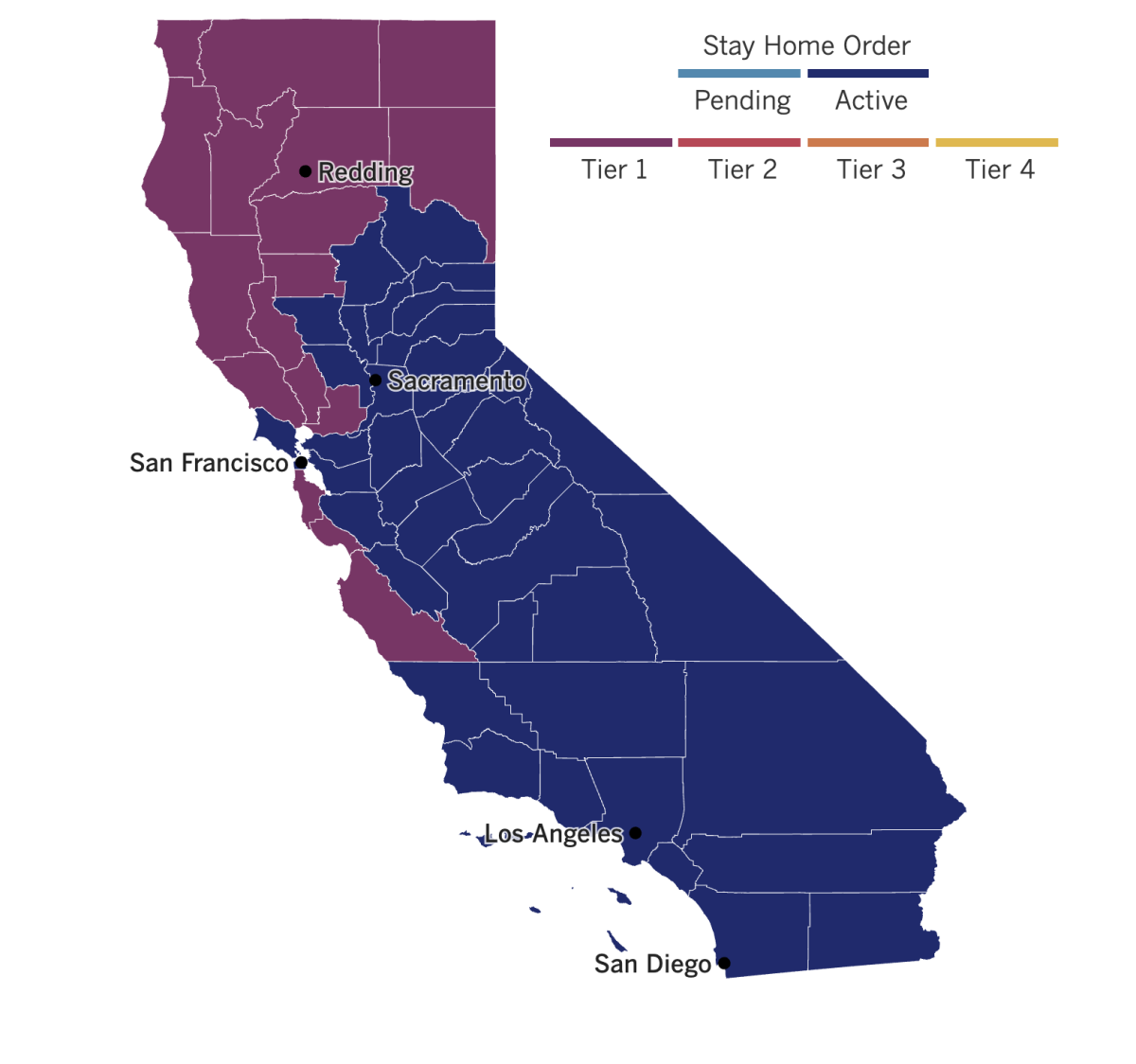
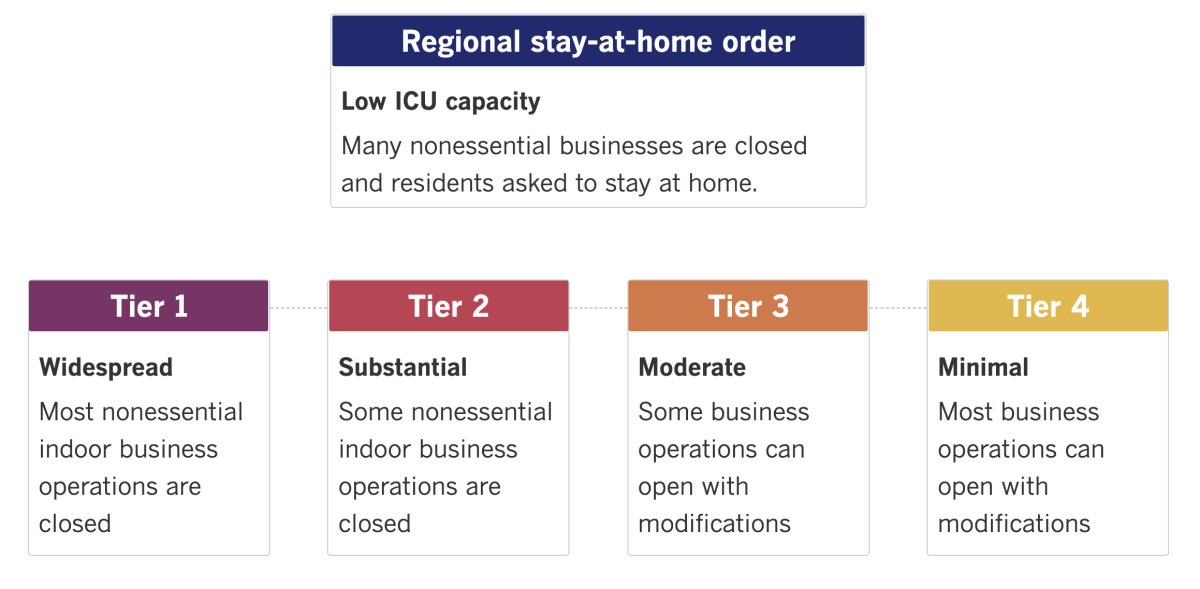
What to read this weekend
Guns, gangs and germs
Perches Funeral Homes, with several branches in El Paso and in Juarez, Mexico, has been laying the dead to rest for more than 50 years — weathering wars, cartel violence, epidemics and mass shootings. But no crisis has filled its crematoriums, chapels and cemeteries like the coronavirus, my colleague Molly Hennessy-Fiske writes.
This week, El Paso County had more COVID-19 cases per capita than any other large metro area in Texas, with 1,282 deaths. Even more have died across the border in Ciudad Juarez: 2,262.
“It’s hit us really, really hard,” said Salvador Perches Jr., 51, son of the funeral homes’ founder. He compared the spike in deaths to the drug cartel slayings that plagued Juarez from 2007 to 2012. COVID-19 deaths are less violent, but just as constant, he said. So is employees’ fear of catching the virus.
“This pandemic, it’s taking it to another level,” he said. “It’s nonstop.”
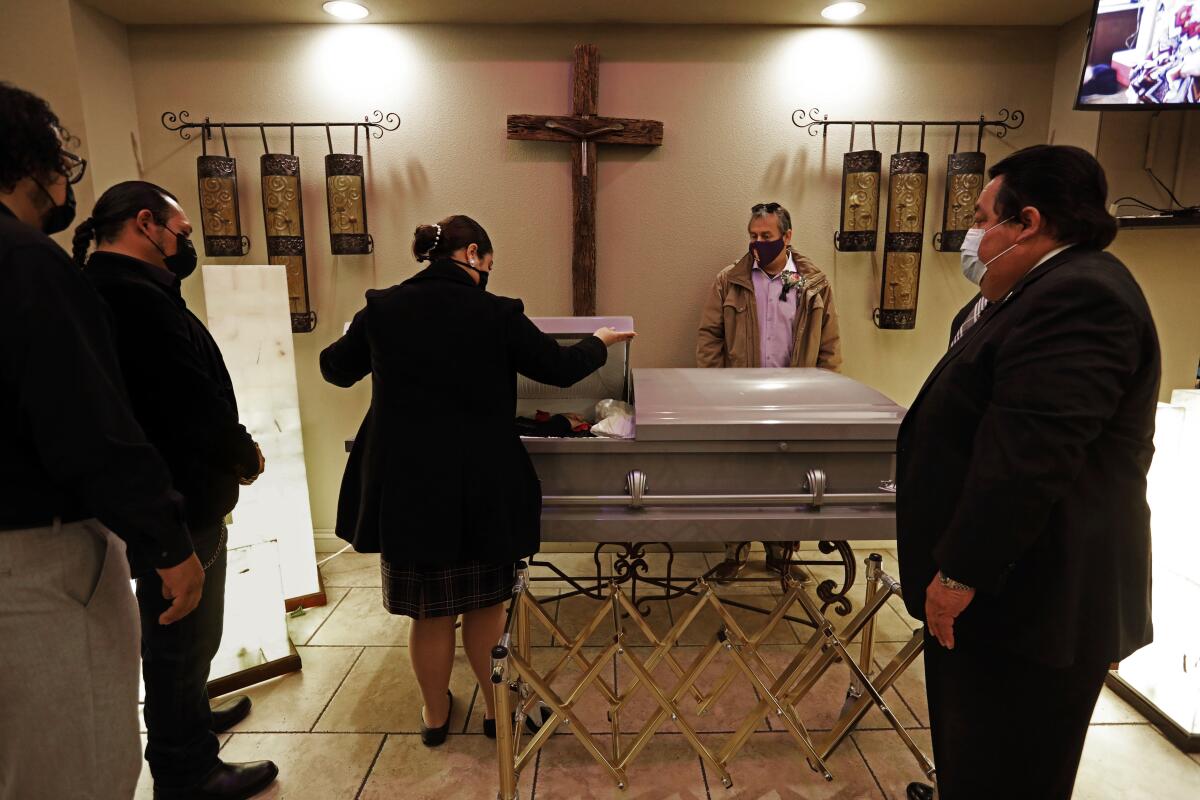
The first panhuman event
That’s what my colleague Daniel Hernandez is calling the pandemic, arguing that thanks to globalization and technology, practically every sentient human from age 3 to more than 100 knows that COVID-19 is happening. “In that sense we’ve found something — finally — that unites us all, from the most remote villages to the most concentrated big cities, such as ours,” he writes.
The internet age, rather than uniting humans, has divided us into increasingly fragmented tribes, he writes. But the pandemic reminds us that we’re all in this together, Hernandez says: “For the first time, everyone everywhere — whether or not they have been directly affected by the virus — is experiencing some degree of the same emotions: fear, anxiety, trepidation, and the sadness and mourning the pandemic has wrought.” Even the reticence of pandemic skeptics can be seen as a reflection of those same feelings, he argues.
Contact tracing in the Navajo Nation
Few groups in the U.S. have been hit harder by the pandemic than Native Americans, who are 3.5 times more likely to contract the virus than white people, according to the CDC. That’s certainly true on the Navajo Nation, the largest reservation in the U.S.
More than a third of COVID-19 deaths in New Mexico are among Native Americans, who make up only 11% of the state’s population. And to date, 17,700 Navajo out of the 175,000 who live in the Navajo Nation have contracted the virus. Nearly 700 have died of it. Now hospitals and their intensive care units are approaching capacity.
My colleague Kurtis Lee spoke to contact tracers in Two Grey Hills, N.M., as they fought to offer solace and sustenance to the afflicted in the sprawling high desert reservation. Marlene Montoya is one of the health workers who spend hours trying to track down people who live off of remote gravel roads with poor cellphone service. Some residents don’t have cellphones, which means house calls — and a higher risk of catching the virus.
Montoya said she spends a lot of time comforting people and overseeing housing demands. “It’s a mix of education and counseling,” she said. “People get sick, they’re scared and looking for us to give them answers.”
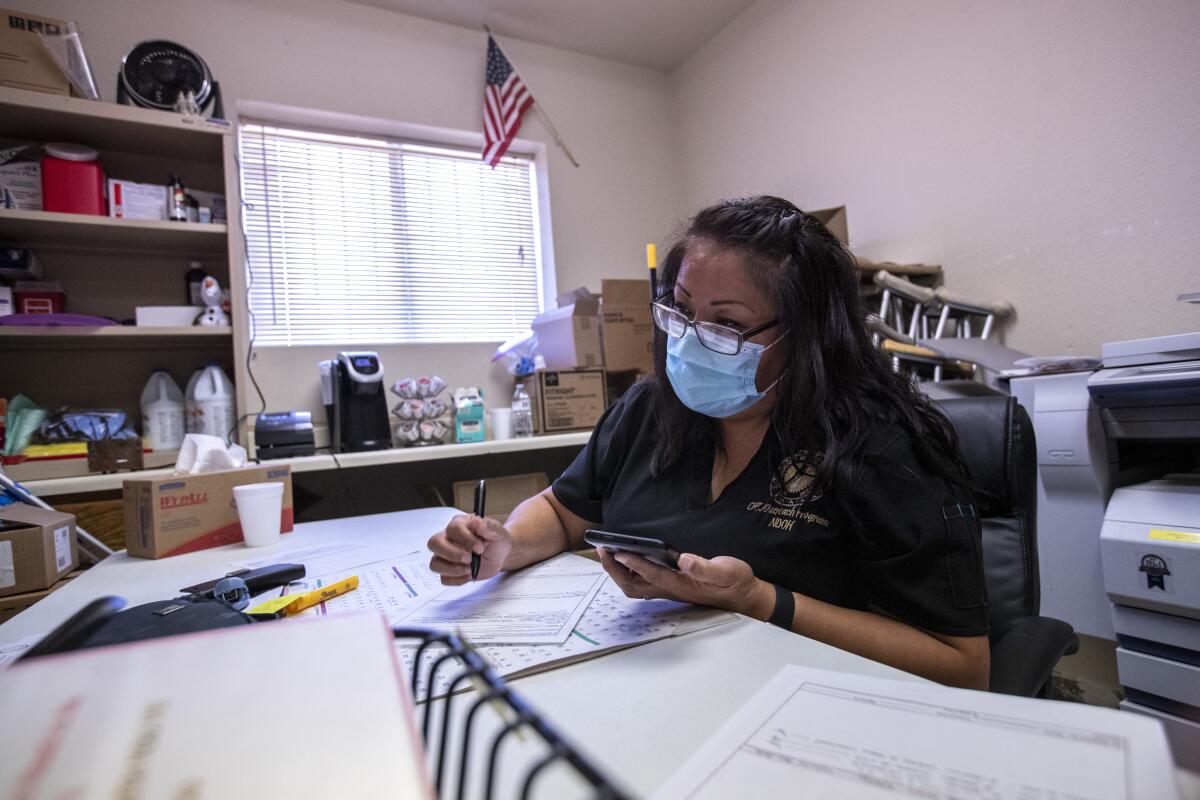
Transmission mystery
From South Korea comes a study with chilling findings for us all: The standard guidelines to remain six feet apart, and to avoiding spending 15 minutes or more in another person’s presence, may not be enough to keep us safe.
The discovery stems from an incident at a restaurant in the city of Jeonju, where diners contracted the virus from an out-of-town visitor, my colleague Victoria Kim writes. One of those infected was a high school student who had just five minutes of exposure from more than 20 feet away.
The study began with a mystery: How did this high schooler test positive in a city that hadn’t seen a coronavirus case in two months? She hadn’t traveled outside the region in recent weeks and had largely gone from home to school and back. Cellphone data revealed the restaurant as a possible connection with a known coronavirus patient visiting from another province. Then the rest fell into place.
Experts say the research points to the need for contact tracers around the world to widen the net when looking for people who may have been exposed. It also underscores the dangers of dining in public. “Eating indoors at a restaurant is one of the riskiest things you can do in a pandemic,” said Linsey Marr, a civil engineering professor at Virginia Tech who was not involved in the study. “Even if there is distancing, as this shows and other studies show, the distancing is not enough.”
Prayer in the time of pandemic
The pandemic left its mark on nearly every aspect of Sunday’s 89th annual Virgen de Guadalupe procession and Mass, my colleague Andrew J. Campa writes.
The colorful procession, which drew 10,000 attendees last year and usually takes place on Cesar Chavez Avenue in East Los Angeles, was for the first time held outside L.A. in part to discourage a large crowd from gathering during the shutdown. And Mass was capped to just 120 in-person, physically distanced participants. (It was also livestreamed to 5,800 viewers.)
Those who were able to participate expressed their deep devotion to the religious celebration. East L.A. resident Jose Juan Morales drove the first vehicle in Sunday’s procession, a pickup truck with an attached flatbed trailer that he had transformed into a shrine on wheels, covered in hundreds of roses and a mural of Our Lady of Guadalupe.
Morales has participated in the devotion for more than a decade but said he feels “extra blessed” to be involved this year. The 45-year-old father of three said he was hospitalized for a week in July with COVID-19 and took three more weeks to fully recover. “I consider it a miracle to be here honoring the Virgen de Guadalupe and believe she saved me,” Morales said.
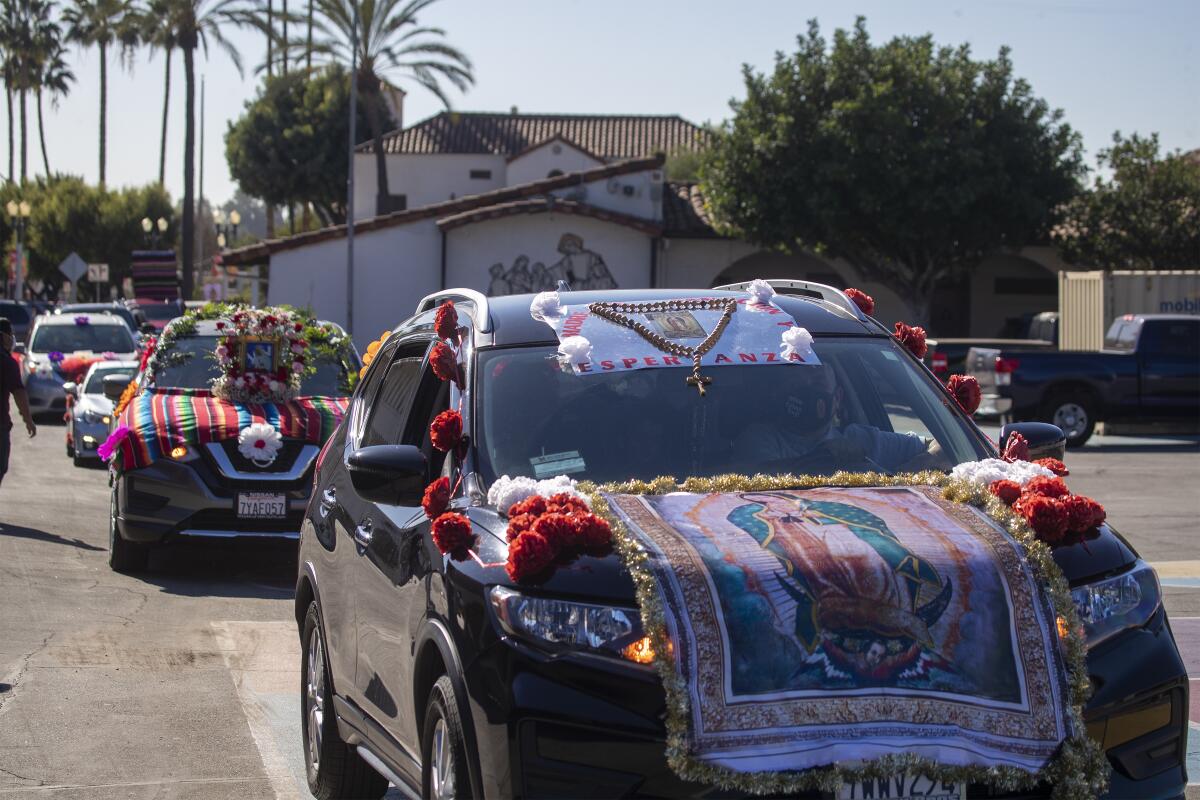
Your support helps us deliver the news that matters most.
What to do this weekend
Get outside. Head to Long Beach to hunt for 60 floating Christmas trees that light up and spin on the city’s waters, from Alamitos Bay to Rainbow Harbor to Spinnaker Bay and El Dorado Park. Or walk the length of California (virtually), from north to south, by signing up to add your daily steps to Walk California, a virtual 957-mile walk that continues through the end of the year. Subscribe to The Wild for more on the outdoors.
Go for a drive. Roll over to the Irwindale Speedway to experience Santa’s Speedway, a drive-through light-show experience where visitors can cruise on a real-life racetrack to enjoy the sights of Santa’s village, lit-up boats and RVs, a tree that’s over 110 feet tall and more. Reserve your tickets for the 45-minute experience ahead of time. Or head to San Clemente to see a 125-foot-tall white fir that is the world’s largest live-cut Christmas tree of the 2020 holiday season (that we know of). Avoid crowds and wear a mask if you go.
Watch something great. Our holiday-themed watch list includes Tony Award winner Jefferson Mays starring in a filmed version of his one-man staging of Charles Dickens’ “A Christmas Carol.” And in his Indie Focus newsletter’s roundup of new movies, Mark Olsen highlights Sundance Film Festival darling “Minari,” which tells the story of a Korean American family as they relocate to Arkansas.
Eat something great. Check out the newest version of The Times’ 101 for Southland restaurant recommendations, including southern Thai staple Jitlada and the mood-lifting Ethiopian at Meals by Genet. Or take a chance on some nontraditional holiday recipes from our test kitchen, including a beef bulgogi bowl with kimchi.
Go online. Here’s The Times’ guide to the internet for when you’re looking for information on self-care, feel like learning something new or interesting, or want to expand your entertainment horizons.The pandemic in pictures

This image of holiday decorations at the Manhattan Beach Pier, taken by my colleague Jay L. Clendenin, sums up this unprecedented holiday season: a show of lights, sparser foot traffic and large, ALL-CAPS warnings to mask up.
The photo is part of a series recounting California’s harrowing 2020, month by month. Many of the photos, obviously, are reflections of a life fundamentally altered by the virus; all are arresting. See for yourself.
Resources
Practice social distancing using these tips, and wear a mask. Here’s how to do it right.
Watch for symptoms such as fever, cough, shortness of breath, chills, shaking with chills, muscle pain, headache, sore throat and loss of taste or smell. Here’s what to look for and when.
Need to get tested? Here’s where you can in L.A. County and around California.
Americans are hurting in many ways. We have advice for helping kids cope, resources for people experiencing domestic abuse and a newsletter to help you make ends meet.
For our most up-to-date coverage, visit our homepage and our Health section, get our breaking news alerts, and follow us on Twitter and Instagram.




